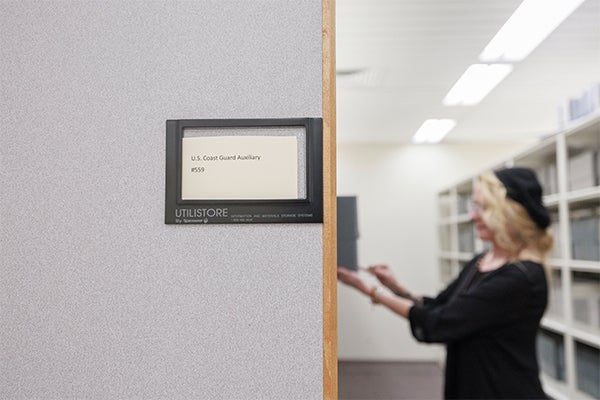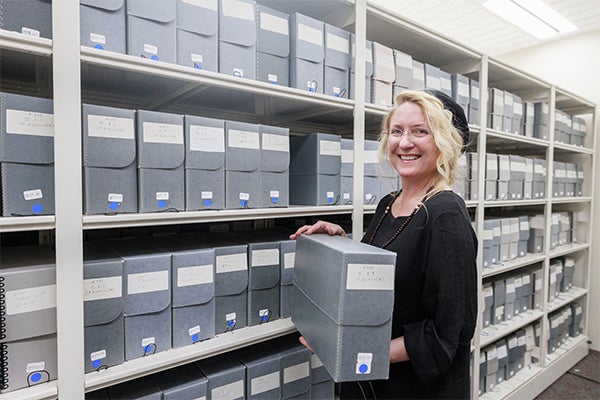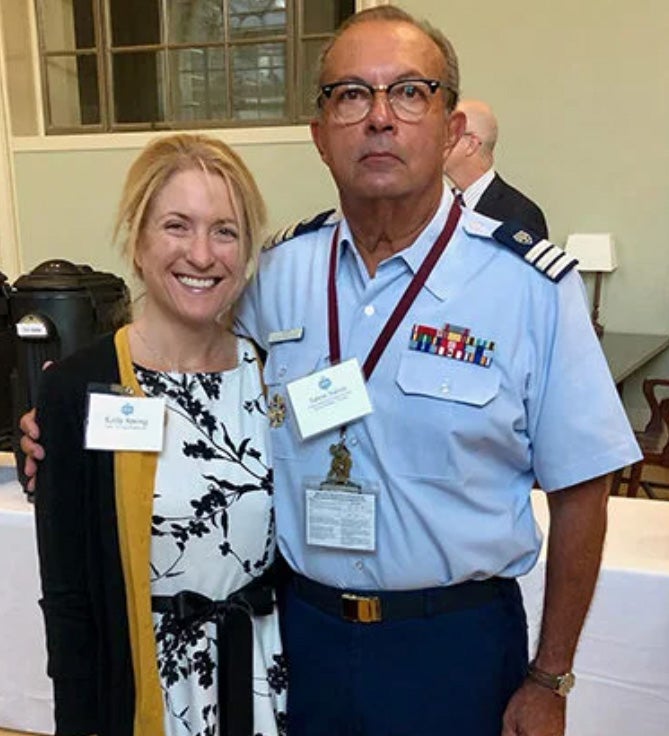Host ECU enhancing Coast Guard Auxiliary collection
The U.S. Coast Guard Auxiliary records manuscript collection spans nearly 350 cubic feet and includes more than 900 boxes in the basement level of the East Carolina University main campus library.
Since Dr. Edwin Nieves was appointed U.S. Coast Guard Auxiliary history division branch chief for archives, he has worked closely with ECU’s Kelly Spring the last few years to enhance, organize and fine-tune this publicly accessible auxiliary records collection. ECU was appointed home to the collection in 1988 thanks in large part to the strong reputation of ECU’s maritime studies program.
The collection is helpful when ECU’s Special Collections division receives a reference question about the U.S. Coast Guard Auxiliary, which is a voluntary, non-military service of the Coast Guard focused on enhancing safety of American waterways and promoting recreational boating safety. Requests to ECU vary, ranging from research questions for books and documentaries, facts, different history aspects and other inquiries.

Kelly Spring puts a box back in its spot in the U.S. Coast Guard Auxiliary records manuscript collection in the ECU main campus library.
“Dr. Nieves has really helped me to understand what are the significant portions of the collection,” said Spring, Academic Library Services’ head of manuscripts and digital curation. “There is organizational history and a lot of photos. Dr. Nieves has come in and spent time going through boxes that he thought would have really important information people would want to know. One example was the uniform history and how it had changed throughout the years, and why did it change. We found that within the boxes and he sent more information about it, so I could add it to our collection guide to give researchers more information for when they are looking.”
“Why ECU?” is a question Spring, Nieves and others in the historical branch of the U.S. Coast Guard Auxiliary are asked and have researched. ECU professor emeritus Richard Stephenson and Donald Lennon, then-director of the ECU manuscript collection during the late 1980s, were instrumental in negotiations for ECU to be chosen as host.
The collection includes a May 13, 1988, letter from U.S. Coast Guard National Commodore William Harr to Lennon, confirming ECU as the collection’s home.

Kelly Spring stands with boxes as part of the U.S. Coast Guard Auxiliary records manuscript collection in the ECU main campus library. (Photos by Steven Mantilla)
“There has long been a need for a permanent home for a collection of documents, publications and related materials which together would contribute to an accurate record of the Coast Guard Auxiliary,” Harr wrote. “The need becomes more acute each year as the members of this 50-year-old public service organization pass on with no place to designate to receive irreplaceable historical materials. Thus, we were very pleased to learn that East Carolina University, known for its excellent program in maritime history, was willing to establish a Coast Guard Auxiliary collection as set forth in your March 30, 1988, letter. To that end, East Carolina University is designated as the permanent repository for the retired Coast Guard Auxiliary records which have not been retained by the U.S. Government and for those private records donated by auxiliary members and others.”
ECU’s role led to Spring’s attendance at the 50th McMullen Naval History Symposium at the U.S. Naval Academy last September. Spring and Nieves presented about the collection and led a talk titled, “Jointly preserving maritime history.”
In addition to presenting during her first time in attendance, Spring enjoyed learning from other presentations and sessions.
“It was great to get out of my field, in a way, but it was still history and research and educational,” Spring said. “It was just on a topic I’m not very well-versed. There were folks there from the Navy, Marine Corps and very military-based. They were talking about all of these different kinds of ships, but there also were others like museums giving presentations about their work. … I really liked a presentation about how a museum worked together to get college students experience in different aspects, not only with museum management, but working with artifacts and processing, in a lot of ways that we do here.”
Nieves, who lives in Virginia, added the symposium was an opportunity to tout the connection between ECU and the U.S. Coast Guard Auxiliary.
“This was an example of collaborative effort between an academic center with a strong naval history tradition and the national U.S. Coast Guard Auxiliary service support of U.S. Coast Guard recreational boating safety,” Nieves said.
Through reviews, evaluations and planning, a goal was established to make the collection as user-friendly as possible.
“We have received, and responded to, a wide range of requests for collection materials,” Nieves said. “These include naval history authors and documentary producers interested in the U.S. Coast Guard Auxiliary service throughout the years. We have also received and responded to requests from individuals across the nation, seeking historical service information of loved ones. Kelly Spring and I have established a pretty good system to receive, at the ECU end, and forward for response, at my U.S. Coast Guard Auxiliary end, to queries about the content of the collection. This integrated system could not be possible or effective without her knowledge about the collection content and flexible, professional approach to these tasks.”

Edwin Nieves and Kelly Spring, left, presented together at the 50th McMullen Naval History Symposium. (Contributed photo)